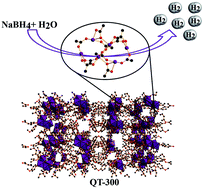High hydrogen release catalytic activity by quasi-MOFs prepared via post-synthetic pore engineering†
Abstract
The catalytic activity of metal–organic frameworks (MOFs) depends largely on the presence of structural defects. In the present study, cobalt based metal–organic framework TMU-10, [Co6(oba)5(OH)2(H2O)2(DMF)4]n·2DMF has been subjected to controlled thermolysis under air atmosphere at different temperatures in the range of 100–700 °C. This treatment results in the removal of ligands, and generation of structural defects and additional porosity in a controlled manner. The resulting materials, denoted as quasi MOFs according to the literature, were subsequently employed as catalysts for hydrogen release from NaBH4 by hydrolysis. The quasi TMU-10 framework obtained at 300 °C (QT-300) shows the highest turnover frequency of the series with a value of 13 333 mL min−1 g−1 at room temperature in the absence of a base, with an activation energy of 56.8 kJ mol−1. The simultaneous presence of micro- and mesopores in QT-300 with unsaturated Lewis acid sites on cobalt nodes due to the conversion of a fraction of Co(II) centers to Co(III) as well as the presence of tetrahedral Co(II) sites is responsible for this catalytic behavior. The influence of the catalyst dosage and BH4− concentration is in good agreement with the Langmuir–Hinshelwood model in which both reactants must be adsorbed onto the catalyst surface. Further investigation on the hydrolysis of the NaBH4 + D2O system presents a primary kinetic isotope effect indicating that water O–H bond cleavage occurs in the rate determining step.

- This article is part of the themed collection: Sustainable Energy & Fuels Recent HOT Articles


 Please wait while we load your content...
Please wait while we load your content...